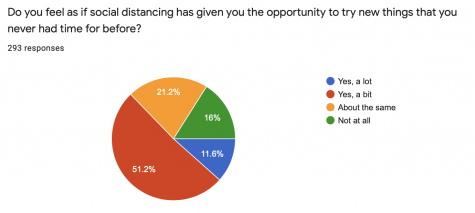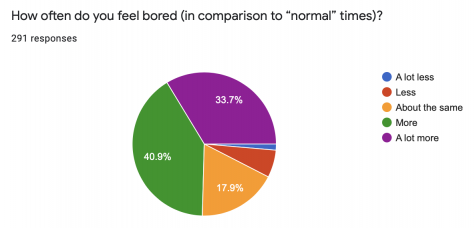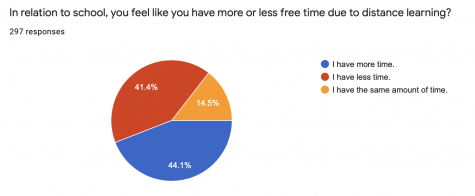Distance Learning: the Good, the Bad, and the Boring

Photo credit: Atessa Anoshiravani
SHC student doodling away her boredom during SIP
Since elementary school, most of us haven’t had much time to be bored. Homework, clubs, commutes, sports, friends, and family took up our days, and technology usually snuffed out the remaining free time. But being stuck at home has eliminated the commitments of clubs and sports, and people can no longer go on social excursions. Commutes have been shortened to shuffling between different rooms of our homes. The pandemic has really put into perspective how much time we used to spend on traveling and enjoying extracurricular activities.
According to the Emerald’s recent student poll, a majority of students reported that they felt they had more free time due to distance learning, and 62.8% of people said they have been able to try new things using that time.

However, 73.6% of students felt bored much more often compared to pre-social distancing. For the most part, they attributed this to the cancelation of co-curricular and extracurricular activities.

41.4% of students who responded actually felt like they have less free time, while 14.5% said they have about the same amount of time. These seemingly contradictory results, feeling like there is less free time but also feeling significantly more boredom, reflect the complexity of the situation.

From my own experience, and from the comments of friends and teachers, living and learning entirely (or almost entirely) at home offers a lot less structure. For non-video conference classes, students can start their work at any time of day, as long as it’s finished before midnight. School starts later every day. There are no extracurriculars to schedule, no buses to catch, no campuses to travel between, no time crunch during the passing periods. Sitting in front of a computer all day with infinite distractions right at one’s fingertips is challenging for those who tend to procrastinate. Even mindless things, like checking a text or scrolling through Instagram for a few minutes add up, especially when there isn’t a teacher in the room making sure you’re on task. Not seeing classmates and teachers everyday adds a level of detachment, making that paper or those notes or the practice problems seem a little less urgent, and making the appeal of pausing to watch a movie or FaceTime a friend much greater.
Back to boredom — learning alone can be a little tiring. There’s no doubt that for most students (and teachers), classes aren’t nearly as fun as they were back when we were at school. Assignments seem to take longer, whether from lack of concentration or disinterest. And in the digital age, boredom had been a rare commodity, with accessible social media and entertainment filling in the gaps of time between activities. In a way, our previous way of living made people forget what being bored was like and how to deal with it.
However, it’s important to remember that having nothing to do is actually really good for us, and that from these slow moments there is potential for creativity and growth. Giving ourselves purposeful time to do nothing gives our brains a break from the constant stimulation we face online and allows us to really spend time with just ourselves. Many studies have shown that when we have nothing to do, our mind can wander, and when it has nothing to turn to, it creates (Learn more here, here, or here). From new art to baking extravaganzas to radical solutions to problems, despite being unappealing, boredom bestows many benefits.
Especially during this quarantine, being at home 24/7 is an opportunity to create, whether for ourselves or for others. Taking a little time out of each day to reflect and unplug, maybe by drawing, writing, exercising, meditating — whatever floats your boat — may just help us all get through this.

After three years of writing and editing for the Emerald, Atessa is serving as Editor-in-Chief during her final year at SHC. She’s an avid bookworm and...





